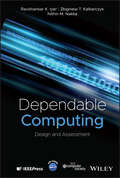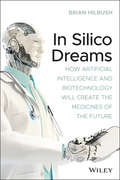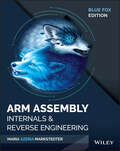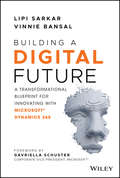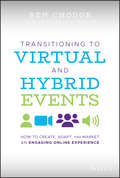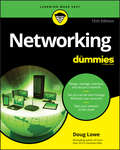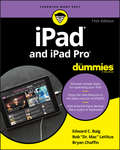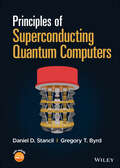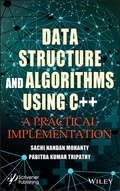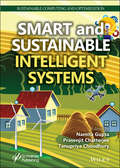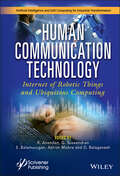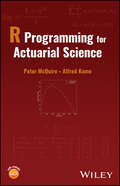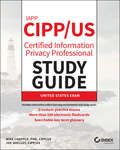- Table View
- List View
Dependable Computing: Design and Assessment (IEEE Press)
by Ravishankar K. Iyer Zbigniew T. Kalbarczyk Nithin M. NakkaDependable Computing Covering dependability from software and hardware perspectives Dependable Computing: Design and Assessment looks at both the software and hardware aspects of dependability. This book: Provides an in-depth examination of dependability/fault tolerance topics Describes dependability taxonomy, and briefly contrasts classical techniques with their modern counterparts or extensions Walks up the system stack from the hardware logic via operating systems up to software applications with respect to how they are hardened for dependability Describes the use of measurement-based analysis of computing systems Illustrates technology through real-life applications Discusses security attacks and unique dependability requirements for emerging applications, e.g., smart electric power grids and cloud computing Finally, using critical societal applications such as autonomous vehicles, large-scale clouds, and engineering solutions for healthcare, the book illustrates the emerging challenges faced in making artificial intelligence (AI) and its applications dependable and trustworthy. This book is suitable for those studying in the fields of computer engineering and computer science. Professionals who are working within the new reality to ensure dependable computing will find helpful information to support their efforts. With the support of practical case studies and use cases from both academia and real-world deployments, the book provides a journey of developments that include the impact of artificial intelligence and machine learning on this ever-growing field. This book offers a single compendium that spans the myriad areas in which dependability has been applied, providing theoretical concepts and applied knowledge with content that will excite a beginner, and rigor that will satisfy an expert. Accompanying the book is an online repository of problem sets and solutions, as well as slides for instructors, that span the chapters of the book.
Dependable Computing: Design and Assessment (IEEE Press)
by Ravishankar K. Iyer Zbigniew T. Kalbarczyk Nithin M. NakkaDependable Computing Covering dependability from software and hardware perspectives Dependable Computing: Design and Assessment looks at both the software and hardware aspects of dependability. This book: Provides an in-depth examination of dependability/fault tolerance topics Describes dependability taxonomy, and briefly contrasts classical techniques with their modern counterparts or extensions Walks up the system stack from the hardware logic via operating systems up to software applications with respect to how they are hardened for dependability Describes the use of measurement-based analysis of computing systems Illustrates technology through real-life applications Discusses security attacks and unique dependability requirements for emerging applications, e.g., smart electric power grids and cloud computing Finally, using critical societal applications such as autonomous vehicles, large-scale clouds, and engineering solutions for healthcare, the book illustrates the emerging challenges faced in making artificial intelligence (AI) and its applications dependable and trustworthy. This book is suitable for those studying in the fields of computer engineering and computer science. Professionals who are working within the new reality to ensure dependable computing will find helpful information to support their efforts. With the support of practical case studies and use cases from both academia and real-world deployments, the book provides a journey of developments that include the impact of artificial intelligence and machine learning on this ever-growing field. This book offers a single compendium that spans the myriad areas in which dependability has been applied, providing theoretical concepts and applied knowledge with content that will excite a beginner, and rigor that will satisfy an expert. Accompanying the book is an online repository of problem sets and solutions, as well as slides for instructors, that span the chapters of the book.
In Silico Dreams: How Artificial Intelligence and Biotechnology Will Create the Medicines of the Future
by Brian S. HilbushLearn how AI and data science are upending the worlds of biology and medicine In Silico Dreams: How Artificial Intelligence and Biotechnology Will Create the Medicines of the Future delivers an illuminating and fresh perspective on the convergence of two powerful technologies: AI and biotech. Accomplished genomics expert, executive, and author Brian Hilbush offers readers a brilliant exploration of the most current work of pioneering tech giants and biotechnology startups who have already started disrupting healthcare. The book provides an in-depth understanding of the sources of innovation that are driving the shift in the pharmaceutical industry away from serendipitous therapeutic discovery and toward engineered medicines and curative therapies. In this fascinating book, you'll discover: An overview of the rise of data science methods and the paradigm shift in biology that led to the in silico revolution An outline of the fundamental breakthroughs in AI and deep learning and their applications across medicine A compelling argument for the notion that AI and biotechnology tools will rapidly accelerate the development of therapeutics A summary of innovative breakthroughs in biotechnology with a focus on gene editing and cell reprogramming technologies for therapeutic development A guide to the startup landscape in AI in medicine, revealing where investments are poised to shape the innovation base for the pharmaceutical industry Perfect for anyone with an interest in scientific topics and technology, In Silico Dreams also belongs on the bookshelves of decision-makers in a wide range of industries, including healthcare, technology, venture capital, and government.
In Silico Dreams: How Artificial Intelligence and Biotechnology Will Create the Medicines of the Future
by Brian S. HilbushLearn how AI and data science are upending the worlds of biology and medicine In Silico Dreams: How Artificial Intelligence and Biotechnology Will Create the Medicines of the Future delivers an illuminating and fresh perspective on the convergence of two powerful technologies: AI and biotech. Accomplished genomics expert, executive, and author Brian Hilbush offers readers a brilliant exploration of the most current work of pioneering tech giants and biotechnology startups who have already started disrupting healthcare. The book provides an in-depth understanding of the sources of innovation that are driving the shift in the pharmaceutical industry away from serendipitous therapeutic discovery and toward engineered medicines and curative therapies. In this fascinating book, you'll discover: An overview of the rise of data science methods and the paradigm shift in biology that led to the in silico revolution An outline of the fundamental breakthroughs in AI and deep learning and their applications across medicine A compelling argument for the notion that AI and biotechnology tools will rapidly accelerate the development of therapeutics A summary of innovative breakthroughs in biotechnology with a focus on gene editing and cell reprogramming technologies for therapeutic development A guide to the startup landscape in AI in medicine, revealing where investments are poised to shape the innovation base for the pharmaceutical industry Perfect for anyone with an interest in scientific topics and technology, In Silico Dreams also belongs on the bookshelves of decision-makers in a wide range of industries, including healthcare, technology, venture capital, and government.
Blue Fox: Arm Assembly Internals and Reverse Engineering
by Maria MarkstedterProvides readers with a solid foundation in Arm assembly internals and reverse-engineering fundamentals as the basis for analyzing and securing billions of Arm devices Finding and mitigating security vulnerabilities in Arm devices is the next critical internet security frontier—Arm processors are already in use by more than 90% of all mobile devices, billions of Internet of Things (IoT) devices, and a growing number of current laptops from companies including Microsoft, Lenovo, and Apple. Written by a leading expert on Arm security, Blue Fox: Arm Assembly Internals and Reverse Engineering introduces readers to modern Armv8-A instruction sets and the process of reverse-engineering Arm binaries for security research and defensive purposes. Divided into two sections, the book first provides an overview of the ELF file format and OS internals, followed by Arm architecture fundamentals, and a deep-dive into the A32 and A64 instruction sets. Section Two delves into the process of reverse-engineering itself: setting up an Arm environment, an introduction to static and dynamic analysis tools, and the process of extracting and emulating firmware for analysis. The last chapter provides the reader a glimpse into macOS malware analysis of binaries compiled for the Arm-based M1 SoC. Throughout the book, the reader is given an extensive understanding of Arm instructions and control-flow patterns essential for reverse engineering software compiled for the Arm architecture. Providing an in-depth introduction into reverse-engineering for engineers and security researchers alike, this book: Offers an introduction to the Arm architecture, covering both AArch32 and AArch64 instruction set states, as well as ELF file format internals Presents in-depth information on Arm assembly internals for reverse engineers analyzing malware and auditing software for security vulnerabilities, as well as for developers seeking detailed knowledge of the Arm assembly language Covers the A32/T32 and A64 instruction sets supported by the Armv8-A architecture with a detailed overview of the most common instructions and control flow patterns Introduces known reverse engineering tools used for static and dynamic binary analysis Describes the process of disassembling and debugging Arm binaries on Linux, and using common disassembly and debugging tools Blue Fox: Arm Assembly Internals and Reverse Engineering is a vital resource for security researchers and reverse engineers who analyze software applications for Arm-based devices at the assembly level.
Blue Fox: Arm Assembly Internals and Reverse Engineering
by Maria MarkstedterProvides readers with a solid foundation in Arm assembly internals and reverse-engineering fundamentals as the basis for analyzing and securing billions of Arm devices Finding and mitigating security vulnerabilities in Arm devices is the next critical internet security frontier—Arm processors are already in use by more than 90% of all mobile devices, billions of Internet of Things (IoT) devices, and a growing number of current laptops from companies including Microsoft, Lenovo, and Apple. Written by a leading expert on Arm security, Blue Fox: Arm Assembly Internals and Reverse Engineering introduces readers to modern Armv8-A instruction sets and the process of reverse-engineering Arm binaries for security research and defensive purposes. Divided into two sections, the book first provides an overview of the ELF file format and OS internals, followed by Arm architecture fundamentals, and a deep-dive into the A32 and A64 instruction sets. Section Two delves into the process of reverse-engineering itself: setting up an Arm environment, an introduction to static and dynamic analysis tools, and the process of extracting and emulating firmware for analysis. The last chapter provides the reader a glimpse into macOS malware analysis of binaries compiled for the Arm-based M1 SoC. Throughout the book, the reader is given an extensive understanding of Arm instructions and control-flow patterns essential for reverse engineering software compiled for the Arm architecture. Providing an in-depth introduction into reverse-engineering for engineers and security researchers alike, this book: Offers an introduction to the Arm architecture, covering both AArch32 and AArch64 instruction set states, as well as ELF file format internals Presents in-depth information on Arm assembly internals for reverse engineers analyzing malware and auditing software for security vulnerabilities, as well as for developers seeking detailed knowledge of the Arm assembly language Covers the A32/T32 and A64 instruction sets supported by the Armv8-A architecture with a detailed overview of the most common instructions and control flow patterns Introduces known reverse engineering tools used for static and dynamic binary analysis Describes the process of disassembling and debugging Arm binaries on Linux, and using common disassembly and debugging tools Blue Fox: Arm Assembly Internals and Reverse Engineering is a vital resource for security researchers and reverse engineers who analyze software applications for Arm-based devices at the assembly level.
Building a Digital Future: A Transformational Blueprint for Innovating with Microsoft Dynamics 365
by Lipi Sarkar Vinnie Bansal2020 has been a challenging year worldwide for many businesses and we have not come out of that phase entirely in 2021.At the same time, we witnessed the acceleration of Cloud led Digital Transformation, changing the ways we work, communicate, collaborate, and share our workspace and creating a globally accepted new normal. More than ever before, senior management and leadership teams need to identify a rigorous approach, drive competitive advantage for their business, create value addition, and become more effective in this work from home, zoom-based collaboration and still achieve our business metrics, which have also naturally evolved due to the global pandemic. Effective disruption is dependent on fast universal adoption, then only it will be real and the transformation will be effective. Understanding the key drivers of change, leveraging the powerful capabilities from technologies with a collaborative platform can aid an organization to prepare for digital transformation. Building a Digital Future provides a clearly defined roadmap for executing this change. Based on their industry experience of leading and implementing digital transformation globally, authors Lipi Sarkar and Vinnie Bansal distil proven ideas, creating a blueprint of powerful and workable frameworks for executing a successful digital transformation with Dynamics 365 and accelerating businesses during a global pandemic. Each chapter of the book is curated with best practices, real life examples, pitfalls to avoid, and salient points to remember. This book enables organizations to truly embrace the benefits of digital transformation by anchoring Microsoft Dynamics 365 and Power Platform at the core of their business. The frameworks, examples and customer stories in the book revolves around how it drives faster disruption, enhances customer experiences, empowers overworked business users. The real-life customer stories across various sectors and countries (namely Virgin Atlantic, Etihad Airways, G&J Pepsi-Cola Bottlers, Breville, Heathrow Airport, Hickory Farms, Ste Michelle Wines and many more) brings an idea of key business challenges and the solutions implemented to address them. Building a Digital Future is written for C-suite stakeholders, senior management, Programme Directors or Managers, Implementation Consultants, and Business Managers who are considering a Digital Transformation to improve efficiencies across the business of finance and operation, supply chain, retail, and customer relationship management--sales, marketing, or services. This book covers Digital Transformation with the powerful technology platform Microsoft Dynamics 365 which offers process capabilities across all business areas, provides powerful tools to automate time-consuming tasks, and drives innovation and improvements through an evergreen system post implementation. The concepts of digital transformation are laid out and take you through a step-by-step transformation journey, highlighting any pitfall that you need to be aware of. Many Dynamics 365 books offer advice for implementation or mastering the system, but Building a Digital Future is the first complete playbook of how businesses can transform to thrive in the digital age. Building a Digital Future is the must-have guide to help your Dynamics 365 program.
Building a Digital Future: A Transformational Blueprint for Innovating with Microsoft Dynamics 365
by Lipi Sarkar Vinnie Bansal2020 has been a challenging year worldwide for many businesses and we have not come out of that phase entirely in 2021.At the same time, we witnessed the acceleration of Cloud led Digital Transformation, changing the ways we work, communicate, collaborate, and share our workspace and creating a globally accepted new normal. More than ever before, senior management and leadership teams need to identify a rigorous approach, drive competitive advantage for their business, create value addition, and become more effective in this work from home, zoom-based collaboration and still achieve our business metrics, which have also naturally evolved due to the global pandemic. Effective disruption is dependent on fast universal adoption, then only it will be real and the transformation will be effective. Understanding the key drivers of change, leveraging the powerful capabilities from technologies with a collaborative platform can aid an organization to prepare for digital transformation. Building a Digital Future provides a clearly defined roadmap for executing this change. Based on their industry experience of leading and implementing digital transformation globally, authors Lipi Sarkar and Vinnie Bansal distil proven ideas, creating a blueprint of powerful and workable frameworks for executing a successful digital transformation with Dynamics 365 and accelerating businesses during a global pandemic. Each chapter of the book is curated with best practices, real life examples, pitfalls to avoid, and salient points to remember. This book enables organizations to truly embrace the benefits of digital transformation by anchoring Microsoft Dynamics 365 and Power Platform at the core of their business. The frameworks, examples and customer stories in the book revolves around how it drives faster disruption, enhances customer experiences, empowers overworked business users. The real-life customer stories across various sectors and countries (namely Virgin Atlantic, Etihad Airways, G&J Pepsi-Cola Bottlers, Breville, Heathrow Airport, Hickory Farms, Ste Michelle Wines and many more) brings an idea of key business challenges and the solutions implemented to address them. Building a Digital Future is written for C-suite stakeholders, senior management, Programme Directors or Managers, Implementation Consultants, and Business Managers who are considering a Digital Transformation to improve efficiencies across the business of finance and operation, supply chain, retail, and customer relationship management--sales, marketing, or services. This book covers Digital Transformation with the powerful technology platform Microsoft Dynamics 365 which offers process capabilities across all business areas, provides powerful tools to automate time-consuming tasks, and drives innovation and improvements through an evergreen system post implementation. The concepts of digital transformation are laid out and take you through a step-by-step transformation journey, highlighting any pitfall that you need to be aware of. Many Dynamics 365 books offer advice for implementation or mastering the system, but Building a Digital Future is the first complete playbook of how businesses can transform to thrive in the digital age. Building a Digital Future is the must-have guide to help your Dynamics 365 program.
Transitioning to Virtual and Hybrid Events: How to Create, Adapt, and Market an Engaging Online Experience
by Ben ChodorCreating virtual events is not as simple as moving the same content online — learn how to immediately leverage virtual solutions for effective in-person online events As the global COVID-19 pandemic continues to have unprecedented impact on both the global economy and the whole of the world population, the need for effectively and efficiently connecting people and the right information has never been more urgent. Although the technology infrastructure currently exists, many organizations are scrambling to create virtual meetings and events to address important time-sensitive issues. Transitioning to Virtual and Hybrid Events explains everything an event host needs to know about going virtual, from understanding the new audience, to adapting content to the new medium, to marketing effectively, and much more. Author Ben Chodor, president of Intrado Digital Media, provides expert advice and real-world instructions for delivering engaging hybrid, virtual, and streaming events and webinars for companies of all sizes and across all industries. Packed with detailed tutorials, real-world case studies, illustrative examples, and highly useful checklists, this comprehensive resource provides step-by-step guidance on: Planning, creating, and implementing a digital event Choosing between a stream, a webcast, or a hybrid event Evaluating different technological solutions Producing compelling virtual content for a variety of scenarios Effectively promoting online events Meeting the needs of a diverse and global audience Transitioning to Virtual and Hybrid Events is an indispensable instruction manual for anyone tasked with enhancing their organization’s continuity plans, enabling their employee base to work remotely, or creating any type of virtual solution to meet this urgent crisis.
Transitioning to Virtual and Hybrid Events: How to Create, Adapt, and Market an Engaging Online Experience
by Ben ChodorCreating virtual events is not as simple as moving the same content online — learn how to immediately leverage virtual solutions for effective in-person online events As the global COVID-19 pandemic continues to have unprecedented impact on both the global economy and the whole of the world population, the need for effectively and efficiently connecting people and the right information has never been more urgent. Although the technology infrastructure currently exists, many organizations are scrambling to create virtual meetings and events to address important time-sensitive issues. Transitioning to Virtual and Hybrid Events explains everything an event host needs to know about going virtual, from understanding the new audience, to adapting content to the new medium, to marketing effectively, and much more. Author Ben Chodor, president of Intrado Digital Media, provides expert advice and real-world instructions for delivering engaging hybrid, virtual, and streaming events and webinars for companies of all sizes and across all industries. Packed with detailed tutorials, real-world case studies, illustrative examples, and highly useful checklists, this comprehensive resource provides step-by-step guidance on: Planning, creating, and implementing a digital event Choosing between a stream, a webcast, or a hybrid event Evaluating different technological solutions Producing compelling virtual content for a variety of scenarios Effectively promoting online events Meeting the needs of a diverse and global audience Transitioning to Virtual and Hybrid Events is an indispensable instruction manual for anyone tasked with enhancing their organization’s continuity plans, enabling their employee base to work remotely, or creating any type of virtual solution to meet this urgent crisis.
Networking For Dummies
by Doug LoweSet up a secure network at home or the office Fully revised to cover Windows 10 and Windows Server 2019, this new edition of the trusted Networking For Dummies helps both beginning network administrators and home users to set up and maintain a network. Updated coverage of broadband and wireless technologies, as well as storage and back-up procedures, ensures that you’ll learn how to build a wired or wireless network, secure and optimize it, troubleshoot problems, and much more. From connecting to the Internet and setting up a wireless network to solving networking problems and backing up your data—this #1 bestselling guide covers it all. Build a wired or wireless network Secure and optimize your network Set up a server and manage Windows user accounts Use the cloud—safely Written by a seasoned technology author—and jam-packed with tons of helpful step-by-step instructions—this is the book network administrators and everyday computer users will turn to again and again.
Networking For Dummies: 11th Edition (For Dummies Ser.)
by Doug LoweSet up a secure network at home or the office Fully revised to cover Windows 10 and Windows Server 2019, this new edition of the trusted Networking For Dummies helps both beginning network administrators and home users to set up and maintain a network. Updated coverage of broadband and wireless technologies, as well as storage and back-up procedures, ensures that you’ll learn how to build a wired or wireless network, secure and optimize it, troubleshoot problems, and much more. From connecting to the Internet and setting up a wireless network to solving networking problems and backing up your data—this #1 bestselling guide covers it all. Build a wired or wireless network Secure and optimize your network Set up a server and manage Windows user accounts Use the cloud—safely Written by a seasoned technology author—and jam-packed with tons of helpful step-by-step instructions—this is the book network administrators and everyday computer users will turn to again and again.
iPad and iPad Pro For Dummies
by Edward C. Baig Bob LeVitus Bryan ChaffinThe A to Z guide to getting the most from your iPad Your iPad is a magical piece of technology connecting you to the rest of the world pretty much anytime and anywhere. Super thin and (well, almost) light as a feather, it allows you to keep up with your day to day duties, stay in touch with family and friends, catch up with work, relax with books and movies, or even create your own works of art! Given all it’s capable of, it’s essential to have a guide to help you make the most of your device. The latest edition of iPad and iPad Pro for Dummies helps users of all experience levels navigate this amazing looking glass. Assuming no prior knowledge, it takes you from the basics—including getting to know the iPad and adding useful accessories such as keyboards and pencils—to setting up email, connecting with other devices, maintaining files, and researching and installing the best apps for you. Discover the simple steps to get up and running Make your iPad work better and faster for you Explore the features of the brand new iPadOS Get easy fixes to common problems Pick up your copy today and find out just how sweet life in Apple tablet form can be!
iPad and iPad Pro For Dummies
by Edward C. Baig Bob LeVitus Bryan ChaffinThe A to Z guide to getting the most from your iPad Your iPad is a magical piece of technology connecting you to the rest of the world pretty much anytime and anywhere. Super thin and (well, almost) light as a feather, it allows you to keep up with your day to day duties, stay in touch with family and friends, catch up with work, relax with books and movies, or even create your own works of art! Given all it’s capable of, it’s essential to have a guide to help you make the most of your device. The latest edition of iPad and iPad Pro for Dummies helps users of all experience levels navigate this amazing looking glass. Assuming no prior knowledge, it takes you from the basics—including getting to know the iPad and adding useful accessories such as keyboards and pencils—to setting up email, connecting with other devices, maintaining files, and researching and installing the best apps for you. Discover the simple steps to get up and running Make your iPad work better and faster for you Explore the features of the brand new iPadOS Get easy fixes to common problems Pick up your copy today and find out just how sweet life in Apple tablet form can be!
Principles of Superconducting Quantum Computers
by Daniel D. Stancil Gregory T. ByrdExplore the intersection of computer science, physics, and electrical and computer engineering with this discussion of the engineering of quantum computers In Principles of Superconducting Quantum Computers, a pair of distinguished researchers delivers a comprehensive and insightful discussion of the building of quantum computing hardware and systems. Bridging the gaps between computer science, physics, and electrical and computer engineering, the book focuses on the engineering topics of devices, circuits, control, and error correction. Using data from actual quantum computers, the authors illustrate critical concepts from quantum computing. Questions and problems at the end of each chapter assist students with learning and retention, while the text offers descriptions of fundamentals concepts ranging from the physics of gates to quantum error correction techniques. The authors provide efficient implementations of classical computations, and the book comes complete with a solutions manual and demonstrations of many of the concepts discussed within. It also includes: A thorough introduction to qubits, gates, and circuits, including unitary transformations, single qubit gates, and controlled (two qubit) gates Comprehensive explorations of the physics of single qubit gates, including the requirements for a quantum computer, rotations, two-state systems, and Rabi oscillations Practical discussions of the physics of two qubit gates, including tunable qubits, SWAP gates, controlled-NOT gates, and fixed frequency qubits In-depth examinations of superconducting quantum computer systems, including the need for cryogenic temperatures, transmission lines, S parameters, and moreIdeal for senior-level undergraduate and graduate students in electrical and computer engineering programs, Principles of Superconducting Quantum Computers also deserves a place in the libraries of practicing engineers seeking a better understanding of quantum computer systems.
Principles of Superconducting Quantum Computers
by Daniel D. Stancil Gregory T. ByrdExplore the intersection of computer science, physics, and electrical and computer engineering with this discussion of the engineering of quantum computers In Principles of Superconducting Quantum Computers, a pair of distinguished researchers delivers a comprehensive and insightful discussion of the building of quantum computing hardware and systems. Bridging the gaps between computer science, physics, and electrical and computer engineering, the book focuses on the engineering topics of devices, circuits, control, and error correction. Using data from actual quantum computers, the authors illustrate critical concepts from quantum computing. Questions and problems at the end of each chapter assist students with learning and retention, while the text offers descriptions of fundamentals concepts ranging from the physics of gates to quantum error correction techniques. The authors provide efficient implementations of classical computations, and the book comes complete with a solutions manual and demonstrations of many of the concepts discussed within. It also includes: A thorough introduction to qubits, gates, and circuits, including unitary transformations, single qubit gates, and controlled (two qubit) gates Comprehensive explorations of the physics of single qubit gates, including the requirements for a quantum computer, rotations, two-state systems, and Rabi oscillations Practical discussions of the physics of two qubit gates, including tunable qubits, SWAP gates, controlled-NOT gates, and fixed frequency qubits In-depth examinations of superconducting quantum computer systems, including the need for cryogenic temperatures, transmission lines, S parameters, and moreIdeal for senior-level undergraduate and graduate students in electrical and computer engineering programs, Principles of Superconducting Quantum Computers also deserves a place in the libraries of practicing engineers seeking a better understanding of quantum computer systems.
Data Structure and Algorithms Using C++: A Practical Implementation
by Sachi Nandan Mohanty Pabitra Kumar TripathyEveryone knows that programming plays a vital role as a solution to automate and execute a task in a proper manner. Irrespective of mathematical problems, the skills of programming are necessary to solve any type of problems that may be correlated to solve real life problems efficiently and effectively. This book is intended to flow from the basic concepts of C++ to technicalities of the programming language, its approach and debugging. The chapters of the book flow with the formulation of the problem, it’s designing, finding the step-by-step solution procedure along with its compilation, debugging and execution with the output. Keeping in mind the learner’s sentiments and requirements, the exemplary programs are narrated with a simple approach so that it can lead to creation of good programs that not only executes properly to give the output, but also enables the learners to incorporate programming skills in them. The style of writing a program using a programming language is also emphasized by introducing the inclusion of comments wherever necessary to encourage writing more readable and well commented programs. As practice makes perfect, each chapter is also enriched with practice exercise questions so as to build the confidence of writing the programs for learners. The book is a complete and all-inclusive handbook of C++ that covers all that a learner as a beginner would expect, as well as complete enough to go ahead with advanced programming. This book will provide a fundamental idea about the concepts of data structures and associated algorithms. By going through the book, the reader will be able to understand about the different types of algorithms and at which situation and what type of algorithms will be applicable.
Data Structure and Algorithms Using C++: A Practical Implementation
by Sachi Nandan Mohanty Pabitra Kumar TripathyEveryone knows that programming plays a vital role as a solution to automate and execute a task in a proper manner. Irrespective of mathematical problems, the skills of programming are necessary to solve any type of problems that may be correlated to solve real life problems efficiently and effectively. This book is intended to flow from the basic concepts of C++ to technicalities of the programming language, its approach and debugging. The chapters of the book flow with the formulation of the problem, it’s designing, finding the step-by-step solution procedure along with its compilation, debugging and execution with the output. Keeping in mind the learner’s sentiments and requirements, the exemplary programs are narrated with a simple approach so that it can lead to creation of good programs that not only executes properly to give the output, but also enables the learners to incorporate programming skills in them. The style of writing a program using a programming language is also emphasized by introducing the inclusion of comments wherever necessary to encourage writing more readable and well commented programs. As practice makes perfect, each chapter is also enriched with practice exercise questions so as to build the confidence of writing the programs for learners. The book is a complete and all-inclusive handbook of C++ that covers all that a learner as a beginner would expect, as well as complete enough to go ahead with advanced programming. This book will provide a fundamental idea about the concepts of data structures and associated algorithms. By going through the book, the reader will be able to understand about the different types of algorithms and at which situation and what type of algorithms will be applicable.
Smart and Sustainable Intelligent Systems (Sustainable Computing and Optimization)
by Namita Gupta Prasenjit Chatterjee Tanupriya ChoudhuryThe world is experiencing an unprecedented period of change and growth through all the electronic and technilogical developments and everyone on the planet has been impacted. What was once ‘science fiction’, today it is a reality. This book explores the world of many of once unthinkable advancements by explaining current technologies in great detail. Each chapter focuses on a different aspect - Machine Vision, Pattern Analysis and Image Processing - Advanced Trends in Computational Intelligence and Data Analytics - Futuristic Communication Technologies - Disruptive Technologies for Future Sustainability. The chapters include the list of topics that spans all the areas of smart intelligent systems and computing such as: Data Mining with Soft Computing, Evolutionary Computing, Quantum Computing, Expert Systems, Next Generation Communication, Blockchain and Trust Management, Intelligent Biometrics, Multi-Valued Logical Systems, Cloud Computing and security etc. An extensive list of bibliographic references at the end of each chapter guides the reader to probe further into application area of interest to him/her.
Smart and Sustainable Intelligent Systems (Sustainable Computing and Optimization)
by Namita Gupta Prasenjit Chatterjee Tanupriya ChoudhuryThe world is experiencing an unprecedented period of change and growth through all the electronic and technilogical developments and everyone on the planet has been impacted. What was once ‘science fiction’, today it is a reality. This book explores the world of many of once unthinkable advancements by explaining current technologies in great detail. Each chapter focuses on a different aspect - Machine Vision, Pattern Analysis and Image Processing - Advanced Trends in Computational Intelligence and Data Analytics - Futuristic Communication Technologies - Disruptive Technologies for Future Sustainability. The chapters include the list of topics that spans all the areas of smart intelligent systems and computing such as: Data Mining with Soft Computing, Evolutionary Computing, Quantum Computing, Expert Systems, Next Generation Communication, Blockchain and Trust Management, Intelligent Biometrics, Multi-Valued Logical Systems, Cloud Computing and security etc. An extensive list of bibliographic references at the end of each chapter guides the reader to probe further into application area of interest to him/her.
Human Communication Technology: Internet-of-Robotic-Things and Ubiquitous Computing (Artificial Intelligence and Soft Computing for Industrial Transformation)
by G. Suseendran R. Anandan S. Balamurugan Ashish Mishra D. BalaganeshThe 16 chapters in this book discuss new architectures, networking paradigms, trustworthiness structures, and platforms for the integration of applications across various business and industrial domains which are needed for the emergence of 'intelligent things' (static or mobile) in collaborative autonomous fleets. These new apps speed up the progress of paradigms of autonomous system design and the proliferation of the Internet of Robotic Things (IoRT). Collaborative robotic things can communicate with other things in IoRT, learn independently, interact securely with the world, people and other things, and acquire characteristics such as self-maintenance, self-awareness, self-healing and fail-operational, due to their ubiquitous nature, the "Internet of Robotic Things" which binds together the sensors and the objects of robotic things is gaining popularity.
Human Communication Technology: Internet-of-Robotic-Things and Ubiquitous Computing (Artificial Intelligence and Soft Computing for Industrial Transformation)
by R. Anandan G. Suseendran S. Balamurugan Ashish Mishra D. BalaganeshHUMAN COMMUNICATION TECHNOLOGY A unique book explaining how perception, location, communication, cognition, computation, networking, propulsion, integration of federated Internet of Robotic Things (IoRT) and digital platforms are important components of new-generation IoRT applications through continuous, real-time interaction with the world. The 16 chapters in this book discuss new architectures, networking paradigms, trustworthy structures, and platforms for the integration of applications across various business and industrial domains that are needed for the emergence of intelligent things (static or mobile) in collaborative autonomous fleets. These new apps speed up the progress of paradigms of autonomous system design and the proliferation of the Internet of Robotic Things (IoRT). Collaborative robotic things can communicate with other things in the IoRT, learn independently, interact securely with the world, people, and other things, and acquire characteristics that make them self-maintaining, self-aware, self-healing, and fail-safe operational. Due to the ubiquitous nature of collaborative robotic things, the IoRT, which binds together the sensors and the objects of robotic things, is gaining popularity. Therefore, the information contained in this book will provide readers with a better understanding of this interdisciplinary field. Audience Researchers in various fields including computer science, IoT, artificial intelligence, machine learning, and big data analytics.
R Programming for Actuarial Science
by Peter McQuire Alfred KumeR Programming for Actuarial Science Professional resource providing an introduction to R coding for actuarial and financial mathematics applications, with real-life examples R Programming for Actuarial Science provides a grounding in R programming applied to the mathematical and statistical methods that are of relevance for actuarial work. In R Programming for Actuarial Science, readers will find: Basic theory for each chapter to complement other actuarial textbooks which provide foundational theory in depth. Topics covered include compound interest, statistical inference, asset-liability matching, time series, loss distributions, contingencies, mortality models, and option pricing plus many more typically covered in university courses. More than 400 coding examples and exercises, most with solutions, to enable students to gain a better understanding of underlying mathematical and statistical principles. An overall basic to intermediate level of coverage in respect of numerous actuarial applications, and real-life examples included with every topic. Providing a highly useful combination of practical discussion and basic theory, R Programming for Actuarial Science is an essential reference for BSc/MSc students in actuarial science, trainee actuaries studying privately, and qualified actuaries with little programming experience, along with undergraduate students studying finance, business, and economics.
R Programming for Actuarial Science
by Peter McQuire Alfred KumeR Programming for Actuarial Science Professional resource providing an introduction to R coding for actuarial and financial mathematics applications, with real-life examples R Programming for Actuarial Science provides a grounding in R programming applied to the mathematical and statistical methods that are of relevance for actuarial work. In R Programming for Actuarial Science, readers will find: Basic theory for each chapter to complement other actuarial textbooks which provide foundational theory in depth. Topics covered include compound interest, statistical inference, asset-liability matching, time series, loss distributions, contingencies, mortality models, and option pricing plus many more typically covered in university courses. More than 400 coding examples and exercises, most with solutions, to enable students to gain a better understanding of underlying mathematical and statistical principles. An overall basic to intermediate level of coverage in respect of numerous actuarial applications, and real-life examples included with every topic. Providing a highly useful combination of practical discussion and basic theory, R Programming for Actuarial Science is an essential reference for BSc/MSc students in actuarial science, trainee actuaries studying privately, and qualified actuaries with little programming experience, along with undergraduate students studying finance, business, and economics.
IAPP CIPP / US Certified Information Privacy Professional Study Guide
by Mike Chapple Joe ShelleyIAPP CIPP / US Certified Information Privacy Professional STUDY GUIDE Your ultimate guide to preparing for the CIPP/US examThe IAPP CIPP / US Certified Information Privacy Professional Study Guide is your one-stop resource for complete coverage of the challenging CIPP/US exam. This Study Guide covers 100% of the CIPP/US domain competencies. You’ll prepare for the exam smarter and faster with Sybex thanks to authoritative and accurate content including practice tests that validate and measure exam readiness. Including an assessment exam, end of chapter review questions, and the two complete practice exams, you get more than 350 questions to hone your test taking skills. You’ll be ready to tackle the rigorous demands of work in the privacy field as you reinforce and retain what you’ve learned with the Sybex online learning environment and test bank, accessible across multiple devices. Get prepared for the CIPP/US exam, and a job in the privacy sector.Coverage of 100% of all exam objectives in this Study Guide means you’ll be ready for:The US privacy environment, including the structure and enforcement of US lawLegal limits on private-sector collection and use of dataGovernment and court access to private-sector informationWorkplace privacyState privacy lawsInteractive learning environmentTake your exam prep to the next level with Sybex’s superior interactive online study tools. To access our learning environment, simply visit www.wiley.com/go/sybextestprep, register your book to receive your unique PIN, and instantly gain one year of FREE access after activation to:Interactive test bank with 2 custom practice exams to help you identify areas where further review is needed. Get more than 90% of the answers correct, and you’re ready to take the certification exam.More than 100 electronic flashcards to reinforce learning and last-minute prep before the examComprehensive glossary in PDF format gives you instant access to the key terms so you are fully preparedAbout the CIPP/US ProgramThe IAPP CIPP/US certification is the ideal credential for those needing a comprehensive understanding of the United States’ data privacy laws and regulations who wish to assist organizations bolster compliance and risk mitigation practices. Visit https://iapp.org/certify/cipp/ for more information.
